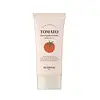What's inside
What's inside
 Key Ingredients
Key Ingredients

 Benefits
Benefits

 Concerns
Concerns

 Ingredients Side-by-side
Ingredients Side-by-side

Water
Skin ConditioningCyclopentasiloxane
EmollientEthylhexyl Methoxycinnamate
UV AbsorberCI 77891
Cosmetic ColorantDipropylene Glycol
HumectantZinc Oxide
Cosmetic ColorantEthylhexyl Salicylate
UV AbsorberCaprylyl Methicone
Skin ConditioningButylene Glycol
HumectantCetyl PEG/PPG-10/1 Dimethicone
EmulsifyingSorbitan Isostearate
EmulsifyingDisteardimonium Hectorite
StabilisingMagnesium Sulfate
Aluminum Hydroxide
EmollientStearic Acid
CleansingCaprylyl Glycol
EmollientParfum
MaskingHydroxyacetophenone
AntioxidantDimethicone
EmollientTriethoxycaprylylsilane
Solanum Lycopersicum Fruit Extract
Antioxidant1,2-Hexanediol
Skin ConditioningCitric Acid
BufferingGlycerin
HumectantLactic Acid
BufferingNelumbo Nucifera Flower Extract
Skin ConditioningPrunus Mume Fruit Extract
HumectantWater, Cyclopentasiloxane, Ethylhexyl Methoxycinnamate, CI 77891, Dipropylene Glycol, Zinc Oxide, Ethylhexyl Salicylate, Caprylyl Methicone, Butylene Glycol, Cetyl PEG/PPG-10/1 Dimethicone, Sorbitan Isostearate, Disteardimonium Hectorite, Magnesium Sulfate, Aluminum Hydroxide, Stearic Acid, Caprylyl Glycol, Parfum, Hydroxyacetophenone, Dimethicone, Triethoxycaprylylsilane, Solanum Lycopersicum Fruit Extract, 1,2-Hexanediol, Citric Acid, Glycerin, Lactic Acid, Nelumbo Nucifera Flower Extract, Prunus Mume Fruit Extract
Water
Skin ConditioningDibutyl Adipate
EmollientSilica
AbrasiveAlcohol Denat.
AntimicrobialEthylhexyl Salicylate
UV AbsorberHomosalate
Skin ConditioningBis-Ethylhexyloxyphenol Methoxyphenyl Triazine
Skin ConditioningMethylene Bis-Benzotriazolyl Tetramethylbutylphenol
UV FilterPolysilicone-15
UV FilterDiethylamino Hydroxybenzoyl Hexyl Benzoate
UV FilterHelianthus Annuus Seed Extract
Skin ConditioningButylene Glycol
HumectantAcrylates Copolymer
Ceteth-10
EmulsifyingStyrene/Acrylates Copolymer
Decyl Glucoside
CleansingSteareth-21
CleansingTromethamine
BufferingPropylene Glycol
HumectantHelianthus Annuus Seed Oil
EmollientXanthan Gum
EmulsifyingTocopherol
AntioxidantAcrylates/C10-30 Alkyl Acrylate Crosspolymer
Emulsion StabilisingCarbomer
Emulsion StabilisingCetyl PEG/PPG-10/1 Dimethicone
Emulsifying1,2-Hexanediol
Skin ConditioningEthylhexylglycerin
Skin ConditioningParfum
MaskingBenzyl Benzoate
AntimicrobialLinalool
PerfumingButylphenyl Methylpropional
PerfumingHexyl Cinnamal
PerfumingCitronellol
PerfumingGeraniol
PerfumingAmyl Cinnamal
PerfumingAlpha-Isomethyl Ionone
PerfumingWater, Dibutyl Adipate, Silica, Alcohol Denat., Ethylhexyl Salicylate, Homosalate, Bis-Ethylhexyloxyphenol Methoxyphenyl Triazine, Methylene Bis-Benzotriazolyl Tetramethylbutylphenol, Polysilicone-15, Diethylamino Hydroxybenzoyl Hexyl Benzoate, Helianthus Annuus Seed Extract, Butylene Glycol, Acrylates Copolymer, Ceteth-10, Styrene/Acrylates Copolymer, Decyl Glucoside, Steareth-21, Tromethamine, Propylene Glycol, Helianthus Annuus Seed Oil, Xanthan Gum, Tocopherol, Acrylates/C10-30 Alkyl Acrylate Crosspolymer, Carbomer, Cetyl PEG/PPG-10/1 Dimethicone, 1,2-Hexanediol, Ethylhexylglycerin, Parfum, Benzyl Benzoate, Linalool, Butylphenyl Methylpropional, Hexyl Cinnamal, Citronellol, Geraniol, Amyl Cinnamal, Alpha-Isomethyl Ionone
 Reviews
Reviews

Ingredients Explained
These ingredients are found in both products.
Ingredients higher up in an ingredient list are typically present in a larger amount.
1,2-Hexanediol is a synthetic liquid and another multi-functional powerhouse.
It is a:
- Humectant, drawing moisture into the skin
- Emollient, helping to soften skin
- Solvent, dispersing and stabilizing formulas
- Preservative booster, enhancing the antimicrobial activity of other preservatives
Butylene Glycol (or BG) is used within cosmetic products for a few different reasons:
Overall, Butylene Glycol is a safe and well-rounded ingredient that works well with other ingredients.
Though this ingredient works well with most skin types, some people with sensitive skin may experience a reaction such as allergic rashes, closed comedones, or itchiness.
Learn more about Butylene GlycolThis ingredient is a high molecular weight silicone. It has emulsifying and skin conditioning properties.
Ethylhexyl Salicylate is an organic compound used to block UV rays. It primarily absorbs UVB rays but offers a small amount of UVA protection as well.
Commonly found in sunscreens, Ethylhexyl Salicylate is created from salicylic acid and 2-ethylhexanol. You might know salicylic acid as the effective acne fighter ingredient and BHA.
The ethylhexanol in this ingredient is a fatty alcohol and helps hydrate your skin, similar to oils. It is an emollient, which means it traps moisture into the skin.
According to manufacturers, Ethylhexyl Salicylate absorbs UV wavelength of 295-315 nm, with a peak absorption at 307-310 nm. UVA rays are linked to long term skin damage, such as hyperpigmentation. UVB rays emit more energy and are capable of damaging our DNA. UVB rays cause sunburn.
Learn more about Ethylhexyl SalicylateParfum is a catch-all term for an ingredient or more that is used to give a scent to products.
Also called "fragrance", this ingredient can be a blend of hundreds of chemicals or plant oils. This means every product with "fragrance" or "parfum" in the ingredients list is a different mixture.
For instance, Habanolide is a proprietary trade name for a specific aroma chemical. When used as a fragrance ingredient in cosmetics, most aroma chemicals fall under the broad labeling category of “FRAGRANCE” or “PARFUM” according to EU and US regulations.
The term 'parfum' or 'fragrance' is not regulated in many countries. In many cases, it is up to the brand to define this term.
For instance, many brands choose to label themselves as "fragrance-free" because they are not using synthetic fragrances. However, their products may still contain ingredients such as essential oils that are considered a fragrance by INCI standards.
One example is Calendula flower extract. Calendula is an essential oil that still imparts a scent or 'fragrance'.
Depending on the blend, the ingredients in the mixture can cause allergies and sensitivities on the skin. Some ingredients that are known EU allergens include linalool and citronellol.
Parfum can also be used to mask or cover an unpleasant scent.
The bottom line is: not all fragrances/parfum/ingredients are created equally. If you are worried about fragrances, we recommend taking a closer look at an ingredient. And of course, we always recommend speaking with a professional.
Learn more about ParfumWater. It's the most common cosmetic ingredient of all. You'll usually see it at the top of ingredient lists, meaning that it makes up the largest part of the product.
So why is it so popular? Water most often acts as a solvent - this means that it helps dissolve other ingredients into the formulation.
You'll also recognize water as that liquid we all need to stay alive. If you see this, drink a glass of water. Stay hydrated!
Learn more about Water